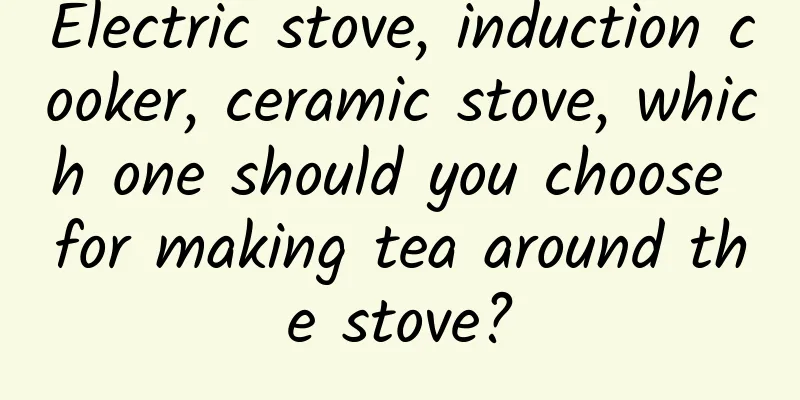Electric stove, induction cooker, ceramic stove, which one should you choose for making tea around the stove?

|
Boiling tea around the stove, the warmth and the aroma of tea, this cozy scene has become a favorite of many people nowadays. If you want to experience this beauty immersively, choosing the right "stove" is the key. There are so many electric stoves, induction cookers, and electric ceramic stoves on the market that it's hard to tell which one is more reliable? Today, we will take you to a comprehensive understanding of the principles, structures, safety, economy, and applicability. The principles are very different, and the heating method determines the experience Electric furnace: As the most traditional heating method, electric current passes through a resistance wire to generate heat, which then heats the container through heat conduction. It is simple and direct, but has low thermal efficiency, slow heating speed, and is prone to uneven heating. Induction cooker: It uses the principle of electromagnetic induction to generate eddy currents at the bottom of the pot to generate heat. It has high thermal efficiency and heats up quickly, but there are restrictions on the material of the pot, which must be ferromagnetic. Electric ceramic stove: It uses the principle of infrared heating to heat the ceramic plate on the stove plate, and then radiates the heat to the bottom of the container. The thermal efficiency is between that of electric stoves and induction cookers, the heating speed is moderate, and there are no special requirements for the material of the pot. Image source: Pixabay The structure is different, and the user experience is different Electric stove: simple structure and affordable price, but the heating plate is exposed, which poses a risk of burns and is not very convenient to clean. Induction cooker: The panel is flat and easy to clean, but it produces electromagnetic radiation when working and has high requirements for cookware. Electric ceramic stove: stylish appearance, uniform panel temperature, not easy to burn, no requirements for the material of the pot, but the price is relatively high. Safety comparison: electricity safety cannot be ignored Electric stove: The heating plate has a high temperature, which poses a risk of burns, and prolonged use may also cause a fire. Induction cooker: The issue of electromagnetic radiation has always attracted much attention. Fortunately, the radiation values of qualified induction cookers on the market are within the safe range. Electric ceramic stove: The panel temperature is relatively low, and it also has overheating protection function, which is relatively safe. Image source: Pixabay Economic considerations, living frugally Electric stove: cheap, low heating efficiency, high electricity consumption, and does not save money in the long term. Induction cooker: moderate price, high thermal efficiency, relatively low power consumption, and high cost performance. Electric ceramic stove: The price is higher, the thermal efficiency is moderate, the power consumption is similar to that of the induction cooker, and the long-term use cost is controllable. Suitability analysis to find the best furnace for you Electric stove: suitable for users with limited budget and low requirements on heating speed. Induction cooker: suitable for users who pursue high efficiency and convenience and have ferromagnetic cookware. Electric ceramic stove: suitable for users who pay attention to safety and user experience and have special requirements for the material of the cookware. Summarize Electric stoves, induction cookers, and ceramic stoves all have their own advantages and disadvantages. Choosing which "stove" is more reliable should be considered comprehensively based on your own needs and budget. If you pursue cost-effectiveness and have ferromagnetic pots, induction cookers are a good choice; if you pay attention to safety and user experience and have no special requirements for the material of the pots, ceramic stoves are more suitable; if the budget is limited and the heating speed is not high, electric stoves can also meet basic needs. I hope this popular science tweet can help you choose the "stove" you like and start a warm and comfortable time of brewing tea around the stove! Source: Chongqing Science Writers Association Author: Zou Jingbo and Tang Lei from Mr. Zou's Science Garden Audit expert: Li Hanbin Statement: Except for original content and special notes, some pictures are from the Internet. They are not for commercial purposes and are only used as popular science materials. The copyright belongs to the original authors. If there is any infringement, please contact us to delete them. |
>>: A barely passed defense helped chemistry turn over the "darkest chapter"
Recommend
What are the channels for online promotion of educational institutions in Changsha?
The Internet has been developed for more than 20 ...
2.4 million followers in one week, revealing the survival rules of Douyin vlog
Although the scale of Douyin 's vlogs is grad...
Bluetooth 4.0 BLE Development
Source code introduction: Integrate the current m...
Multi-screen interaction: the general trend of the home entertainment era
At a time when smart hardware is developing rapid...
Baise Game Mini Program Customization Price Inquiry, How much does it cost to customize the Baise Game Mini Program?
There are two types of customization of Baise Gam...
This mountain looks so beautiful!
We always have a preference for mountains. Whethe...
Fried chicken with cola = high fat and high sugar? Research proves: heavy casualties of pancreatic islet cells!
When eating fried chicken, you must drink Coke! I...
Outrageous! Why would anyone want a dog to treat a cow? | Nature Trumpet
Welcome to the 25th issue of the Nature Trumpet c...
Steve Jobs once wanted a TV like this, and Hisense helped him realize it
To date, Apple has not yet produced a complete te...
If your phone freezes, turn off these 5 features and it will be as smooth as a new one! Have you learned it?
Mobile phones are just like computers. After a sh...
The eye of the storm on Jupiter: More than just a big red eye
James Webb Space Telescope Observes Jet Stream St...
Gmail for iOS: Handling emails in notifications
After this upgrade, users can finally simply proc...
The secret that the queen wants to know most: Snow White's beauty secrets~~
Author: Chen Zhenzhen, Chief Pharmacist, Xiamen U...
It turns out that the Apple developer account [Chinese registration entrance] is here. It is said that 99% of people don’t know it~
When Apple announced the launch of Search Ads, it...
Silicon Valley Big Data Project Flink Real-time Data Warehouse September 2021
Brief introduction to the resources of Flink real...









